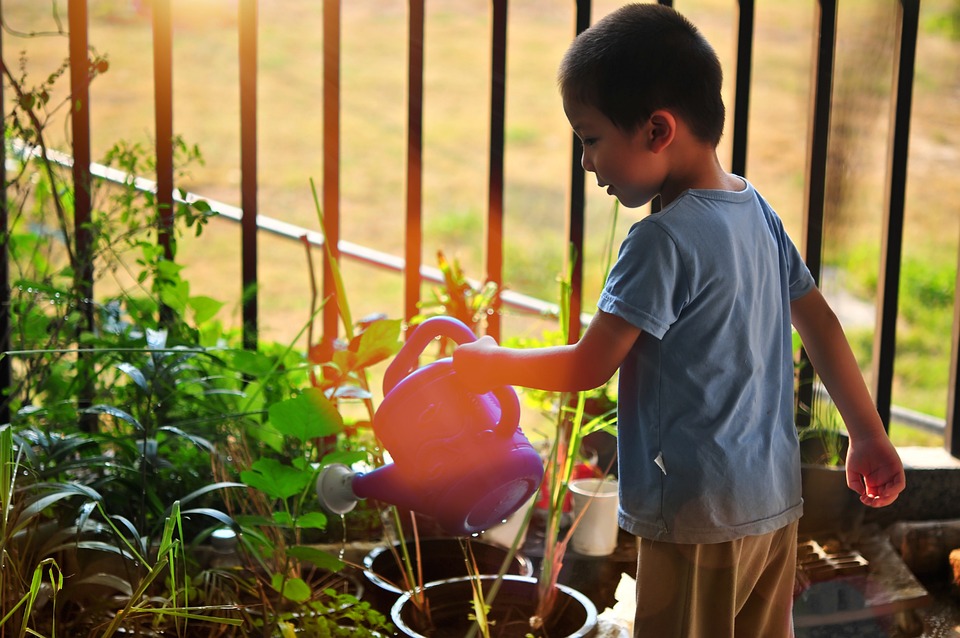In this article, we will discuss how to create a simple Child’s window box, which they can create with the help of an adult.
As said previously in an article the secret of making gardening fun for children is to find a way for them to get instant results with very little effort. We all know children like to watch seeds germinate, which is a good way of teaching them patience.

They may want the results yesterday but they can overcome this impulse.
Ideal seeds to use are Nasturtiums, Candytuft, Zinnia, Cosmos, Marigolds, dahlia, and pot marigold. They are the best because the seeds are easy to handle. After all, they are large and easy to grab with tiny fingers.
They are also quick to germinate and they produce large, colourful blooms, It is best to raise seeds individually in pots in a sunny windowsill and to plant them in the window box when they are large enough to be transplanted to their final destination.
If the plant resents being transplanted then you can sow them directly. This includes plants like the Californian poppy. If you do not have the time to plant seeds, you can buy bedding plants in the form of plug plants or garden-ready plugs.
Children can then pot these on and look after them until they are ready to be planted out. Flowering bulbs also reliably flower in containers to give a boost of colours.
To accomplish this, buy a wide range of dwarf and low-growing types with bright flowers that bloom from late winter to late spring and can help the children to fill the window box in layers according to the planting depth stated on the packaging. This will give the child the best impression of gardening.
It is best to buy a wooden planter and use that as a window box. To this, a hint of colour can be added by painting a rich bluish-black. This makes it a perfect ploy to the sun-loving zinnia and variegated Kingfisher daisies. You can also use dwarf Dahlias and Arctotis to give that extra colour.
CREATING A CHILD’S WINDOW BOX
Place a drip tray at the base of the planter to protect the wood for long-term protection from damp. You will then need to line the inside of the window box with a black plastic liner. Trim off the excess liner that hangs over the edge by using a pair of sharp scissors.
At the bottom of the planter, add a 2.5cm layer of washed gravel and on top of this add multipurpose compost to nearly the rim of the planter.
In the box plant out at even space a row of 3 variegated Felicia amelloides along the front of the window box.

In the gaps between the Felicia plant Kingfisher daisies leaning slightly forward as you plant them. This is done so that the rim of the box is softened and that the straight edge has a mix of flowers and foliage. At the back of the kingfish daisies and Felicia add a row of Zinnias and fill any gaps in between the plants with more potting mixtures. It is best if the plants are evening spaced to give a better appearance.
Stagger the flower colours where the zinnias will continue to bloom on side shoots produced. Once the terminal blooms have been removed be sure to deadhead regularly as this will prolong the flowering season. In place of zinnias, you can use striped French Marigold and Rudbeckias to make a great alternative.
CREATING A WINDOW BOX WITH A TOPIARY CAT
In this display, a cat figure sitting on a bed of pansies is likely to appeal to cat lovers and is especially suitable for children. To do this buy a plant that would fit a plastic trough inside it.
Paint the planter with black and white stripes (using masking tape to keep the lines clean). You can then buy stencils and spray stencil paint to etch black cats in the white stripes and white cats on the black stripes. You will now have a black and white striped planter that on top of them have black and white cat motifs.
Line the trough with a liner so that any excess water can drain away through holes in the box. Fill the box with a layer of washed gravel that is 2.5cm thick and t

hen fill to near the rim with good quality, multipurpose compost.
In the centre of the planter place a topiary cat. At each side plant an ivy (Hedera helix ‘Sagittifolia’) so that it can be trained to go around the cat frame, tie them in and train them by constantly tying them in.
At the side plant alternate blue and yellow pansies at the base of the cat, working and filling gaps around the root ball, so that every space is covered.
An alternative to pansies is to use mixed French marigold or Mimulus hybrids as they will work well.
Give the box a good watering and when the flowers fade, you can pinch them off to promote more flowers and a longer flowering season. You will need to feed regularly and water to keep the displays the best.
CONCLUSIONS
In this article, the way a child can create a window box display has been discussed. This is a fun activity for the child as it will help them to get the creative juices going. Remember in this activity the child is the centre and not you. They are not difficult to make at all and all that you need to do is buy a suitable planter, line it, fill it with compost and then plant it with suitable varieties of plants.
The good thing is that the children can grow their own plants, so they can really get involved in them. If you do not have the time to help them grow the flowers from seeds, you can buy plug or garden-ready plants and use them as suggested in this article.
A fun project for you to undertake with your children, which you can adapt to your situation.
If you have any questions or comments that you wish to ask, please do so in the comment box below.
Let your child get creative by using a window box today.
